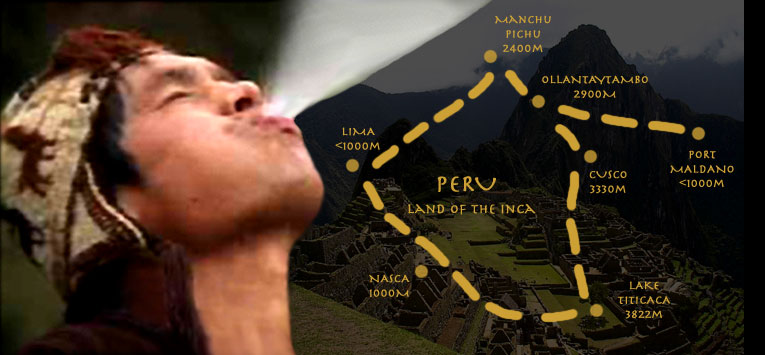

..............................................................................Mission | Press Kit | Crew Bios | Despacho | Multimedia
.................................................................Copyright ©2002 - Contact - Lofu Productions
Site Design By: James Saldana![]()

Western medicine is constantly developing antibiotics and medical treatments through scientific research to cure new diseases that threaten the world’s population .
Due to globalization these two medical traditions have been brought face to face in Peru. Will these two viable medical practices reach a happy equilibrium or will globalization cause the extinction of the medicine traditions of a culture over 500 years old?
“Despacho” is a DVCAM documentary showing how through a cultural exchange of Inca shamanism techniques and western medicine Peruvian and American societies can be healed. This film will give the audience a never before seen look at the effects of globalization by examining this cultural exchange through the eyes of Denise Kinch. Denise Kinch will guide the viewer through her two journeys to learn the shaman’s healing secrets and administer western medicine to treat epidemics in isolated indigenous communities. This film is intended for entry in the international film festival circuit, domestic/international broadcasts, and domestic/international distribution. This proposal is the result of two years of contact with Denise and research on this cultural exchange.
Today, the majority of the indigenous tribes have moved from their rainforest, mountain, or desert origins closer to the cities, and have become dependant on western customs, including medical treatment. The drawback is that many tribal communities cannot afford western medicines, resulting in epidemics (diarrhea, parasites, fungal diseases, etc.) that once could be cured by the now ostracized medicine men. Currently, the Peruvian shamans’ vast knowledge of medicinal plants and healing ceremonies are being lost; while the once culturally rich indigenous tribes of Peru are dying out trying to live up to western standards they cannot afford.
“Despacho” will explore the present situation through the perspective of Denise Kinch, president of Vanishing Cultures. The mission of Vanishing Cultures, a Massachusetts based not-for-profit organization is to preserve the practices of the indigenous shamans and treat medical epidemics in poor remote mountain villages. Denise achieves these goals by leading two different 10 day expeditions in Peru
In the first 10 day expedition, Denise leads a group of advanced Inca Medicine Wheel students to learn the sacred ceremonies of the Q’ero shamans and the “ayahuasceros”. First they travel to the Sacred Valley in Peru to participate in workshops with Don Martin Pinedo, the most renowned shaman in the South of Peru . After participating in ceremonies with Don Martin, the group travels south to a tributary of the Amazon, The Madre de Dios River to learn the plant medicine of the jungle shaman.. They participate in various psychedelic plant ceremonies and learn the history of the jungle medicine. In this expedition Denise’s goal is to preserve these shamanic practices by teaching it to students who accompany her on this self-enlightening journey through the Andes and the Amazon River Basin.
The goal of Denise’s second 10 day expedition is to treat epidemics in poor remote Andean villages. In this expedition she leads an American/Peruvian medical team to administer healthcare for emphysema, parasitic infections, dental needs, malnutrition, etc to indigenous villages 13,000 ft. in the Andes. The indigenous communities don’t have enough monetary or medical resources to treat their problems, and the end result is a high infant mortality rate, high percentage of emphysema, and dental problems. As a result of globalization, Denise has been working 6 years to change this. During her work, she has seen the infant mortality rate drop from 35% to 15% and seen an increased level of government development and support in indigenous communities.
Through globalization the traditional role of the Peruvian shaman has been permanently changed because of increased cultural contact with people such as Denise Kinch. By editing these two expeditions together, the viewer will see how the Peruvian shaman has been transformed from an essential part of an indigenous community to an oddity that teaches mystical 500 year old medical traditions to eager foreigners. All the while, his position of healing his community has been replaced by western doctors using foreign medicines, which the indigenous communities cannot otherwise afford. These two expeditions will be edited together to show the positive and negative elements of the increased cultural contact.
Previous documentaries on Peru tended to focus on the animals of the Amazon, completely omitting the indigenous people, or focused on native people and their culture presenting them as an exotic locale. This film is different because it considers how the lives of the indigenous Peruvians are inextricably connected to the changing world around them. In our view Peru is not just an exotic locale, but instead by understanding the changes in Peru the viewer can understand how the world is transforming. The film’s form, the juxtapositioning of the two expeditions, will allow the viewer to explore how this transformation occurs and the positive and negatives that happen to a disappearing culture along the way.